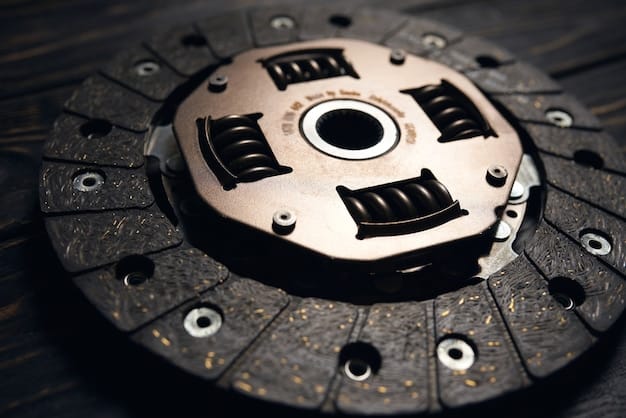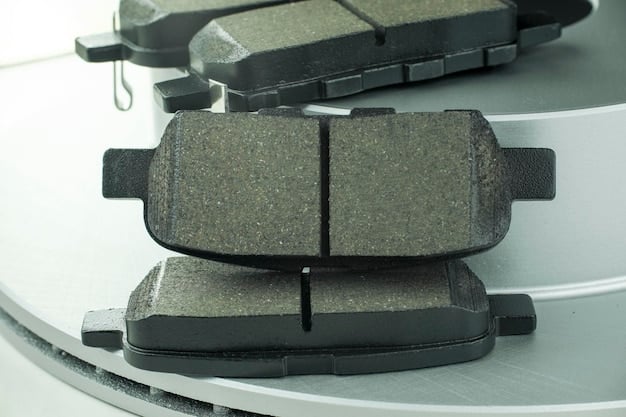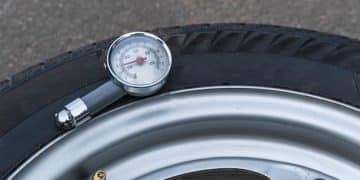Brake Pad Replacement: When to Replace Them and How to Choose the Right Ones

Brake pad replacement is crucial for vehicle safety, typically needed every 30,000 to 70,000 miles, depending on driving habits and brake pad quality, and involves selecting the right type of pads for your car and ensuring proper installation.
Ensuring your vehicle’s safety starts with understanding when and how to handle brake pad replacement. This guide will walk you through everything you need to know.
Brake Pad Replacement: Understanding the Basics
Brake pads are a critical component of your vehicle’s braking system, responsible for providing the friction needed to slow down or stop your car. Over time, these pads wear down due to the constant pressure and heat generated during braking. Understanding the basics of brake pads and their function is the first step in knowing when they need replacement.
Knowing the signs and understanding the factors influencing wear can help you stay ahead of potential problems, ensuring your safety and the longevity of your vehicle’s braking system.
What are Brake Pads?
Brake pads are friction materials that press against the brake rotors to slow down or stop your vehicle. They are attached to a metal backing plate and are designed to withstand the intense heat and pressure generated during braking.
How do Brake Pads Work?
When you press the brake pedal, hydraulic pressure forces the brake caliper to squeeze the brake pads against the rotor. This friction converts kinetic energy into heat, slowing the vehicle. The effectiveness of this process depends on the condition and quality of the brake pads.

In summary, understanding the basics of brake pads—what they are and how they work—sets the stage for recognizing when they need replacement. By staying informed, you can ensure your vehicle’s braking system remains in optimal condition, promoting safety and reliability.
Recognizing the Signs: When to Replace Brake Pads
Knowing when to replace your brake pads is crucial for maintaining vehicle safety. Several indicators can alert you to the need for replacement, ranging from audible cues to visual inspections. Paying attention to these signs can prevent more serious damage and ensure your braking system functions effectively.
Common signs indicating that your brake pads may need replacement include squealing noises, grinding sounds, decreased braking responsiveness, and visual wear of the pads themselves.
- Squealing Noises: Many brake pads have a built-in wear indicator that produces a high-pitched squeal when the pads are nearing the end of their life.
- Grinding Sounds: This usually indicates that the brake pads are completely worn down, and the metal backing plate is grinding against the rotor. This can cause significant damage to the rotors.
- Decreased Braking Responsiveness: If you notice that your car takes longer to stop or the brake pedal feels soft, it may be a sign of worn brake pads.
- Visual Inspection: Regularly inspect your brake pads for wear. If the pads are less than ¼ inch thick, it’s time for a replacement.
Ignoring these signs can lead to more extensive and costly repairs. Catching brake pad issues early can save you money and prevent unsafe driving conditions. Regular inspections and timely replacements are key to maintaining a safe and reliable vehicle.
Factors Affecting Brake Pad Wear
Several factors can influence the rate at which your brake pads wear down. Driving habits, the type of brake pads you use, and the conditions in which you drive all play a significant role in determining how often you’ll need to replace your brake pads.
Understanding these factors can help you extend the life of your brake pads and improve your vehicle’s overall performance.
These factors can typically be grouped into driving habits, the type of brake pad material and the driving conditions.
Driving Habits
Aggressive driving habits, such as hard braking and frequent stops, can significantly accelerate brake pad wear. Conversely, smoother, more gradual braking can help extend the life of your pads.
Brake Pad Material
Different types of brake pads, such as organic, ceramic, and metallic, have varying levels of durability. Ceramic pads, for example, tend to last longer than organic pads but may come at a higher cost.
Driving Conditions
Driving in hilly or mountainous areas, as well as in heavy traffic, can increase brake pad wear due to the increased frequency of braking. Additionally, exposure to harsh weather conditions, such as salt and snow, can contribute to faster wear.

In conclusion, understanding these factors can empower you to make informed decisions about your driving habits and brake pad selection. By paying attention to these influences, you can optimize brake pad lifespan and maintain a safer, more efficient vehicle.
Choosing the Right Brake Pads: Materials and Types
Selecting the right brake pads for your vehicle involves understanding the different materials and types available. Each type offers unique advantages and disadvantages in terms of performance, durability, and cost. Making an informed choice ensures optimal braking performance and safety.
The different brake pad types include organic, semi-metallic, ceramic and more.
- Organic Brake Pads: Made from natural materials like rubber, carbon, and glass, organic brake pads are quiet and provide good stopping power. However, they tend to wear down more quickly and produce more dust.
- Semi-Metallic Brake Pads: These pads are made from a combination of metal fibers and organic materials. They offer a good balance of performance and durability, making them a popular choice for many vehicles.
- Ceramic Brake Pads: Composed of ceramic fibers and bonding agents, ceramic brake pads are known for their quiet operation, long lifespan, and minimal dust production. They also provide excellent braking performance in a wide range of temperatures.
Choosing the right brake pads depends on your driving style, vehicle type, and budget. Consider factors like noise level, durability, and braking performance when making your decision.
Ultimately, selecting the right brake pads involves balancing your specific needs with the characteristics of each type. Whether you prioritize longevity, performance, or cost, understanding the differences between organic, semi-metallic, and ceramic pads will help you make a well-informed decision. By choosing wisely, you can ensure your vehicle’s braking system performs reliably and safely.
Step-by-Step Guide: How to Replace Brake Pads
Replacing brake pads is a task that many car owners can handle themselves with the right tools and knowledge. This step-by-step guide provides clear instructions and safety tips to help you perform a brake pad replacement safely and effectively.
This guide includes detailed steps like preparation, removing the old pads and installing the new ones.
Preparation
Gather all the necessary tools, including a wrench set, socket set, brake cleaner, brake grease, a C-clamp, and new brake pads. Ensure you have a safe workspace and wear gloves and eye protection.
Removing the Old Brake Pads
Loosen the lug nuts on the wheel, jack up the car, and secure it with jack stands. Remove the wheel and locate the brake caliper. Use a wrench to remove the caliper bolts and carefully slide the caliper off the rotor. Remove the old brake pads from the caliper.
Installing the New Brake Pads
Use a C-clamp to compress the caliper piston back into its bore. Apply brake grease to the backing plates of the new brake pads and install them into the caliper. Slide the caliper back over the rotor and reinstall the caliper bolts. Tighten the bolts to the manufacturer’s specifications.
In summary, following these steps carefully will help you successfully replace your brake pads. Remember to prioritize safety, use the right tools, and consult your vehicle’s manual for specific torque specifications. Regular maintenance and timely replacements ensure your braking system remains in top condition, promoting safe driving.
Maintaining Your Brakes: Best Practices and Tips
Proper brake maintenance is essential for ensuring your vehicle’s safety and longevity. Regular inspections, cleaning, and timely replacements can help keep your brakes in optimal condition. Implementing best practices and following helpful tips can prevent costly repairs and ensure reliable braking performance.
These practices include regular inspections, cleaning and lubrication, and proper break-in procedures.
- Regular Inspections: Inspect your brake pads, rotors, and brake lines regularly for signs of wear and damage. Check the brake fluid level and condition.
- Cleaning and Lubrication: Clean the brake components with brake cleaner to remove dust and debris. Lubricate the caliper slide pins with brake grease to ensure smooth movement.
- Proper Break-In Procedures: Follow the manufacturer’s recommended break-in procedures for new brake pads. This typically involves performing a series of controlled stops to properly seat the pads against the rotors.
Adopting these maintenance practices will help extend the life of your brakes and ensure reliable performance. Regular care and attention can prevent minor issues from escalating into major problems.
In conclusion, maintaining your brakes through regular inspections, cleaning, and proper break-in procedures is vital for vehicle safety and longevity. By implementing these best practices and tips, you can ensure your braking system remains in top condition, providing you with reliable stopping power and peace of mind on the road.
| Key Point | Brief Description |
|---|---|
| ⚠️ Signs of Wear | Squealing, grinding, or decreased responsiveness indicate pad wear. |
| 🛠️ Replacement Time | Replace pads every 30,000 to 70,000 miles or when they’re ¼ inch thick. |
| 🧰 Pad Types | Choose between organic, semi-metallic, and ceramic based on driving needs. |
| 🔧 Maintenance | Regular inspections and cleaning extend brake life and ensure safety. |
FAQ
▼
Brake pads typically need replacement every 30,000 to 70,000 miles, depending on driving habits and brake pad material. Regular inspections can help determine the best time for replacement.
▼
Common signs include squealing or grinding noises, decreased braking responsiveness, and a brake pedal that feels soft or spongy. If you notice any of these, it’s time to inspect your brake pads.
▼
Yes, many car owners can replace brake pads themselves with the right tools and knowledge. However, if you’re not comfortable working on your car, it’s best to have a professional mechanic do the job.
▼
The best type of brake pads depends on your driving style and vehicle type. Organic pads are good for everyday driving, while semi-metallic and ceramic pads offer better performance and durability.
▼
Smooth and gradual braking, avoiding aggressive stops, and regular brake maintenance can help extend the life of your brake pads. Also, choose high-quality brake pads designed for longevity.
Conclusion
Understanding when to replace your brake pads and how to choose the right ones is essential for maintaining vehicle safety. By staying informed and proactive, you can ensure your braking system remains in optimal condition, providing you with reliable stopping power and peace of mind on the road.





